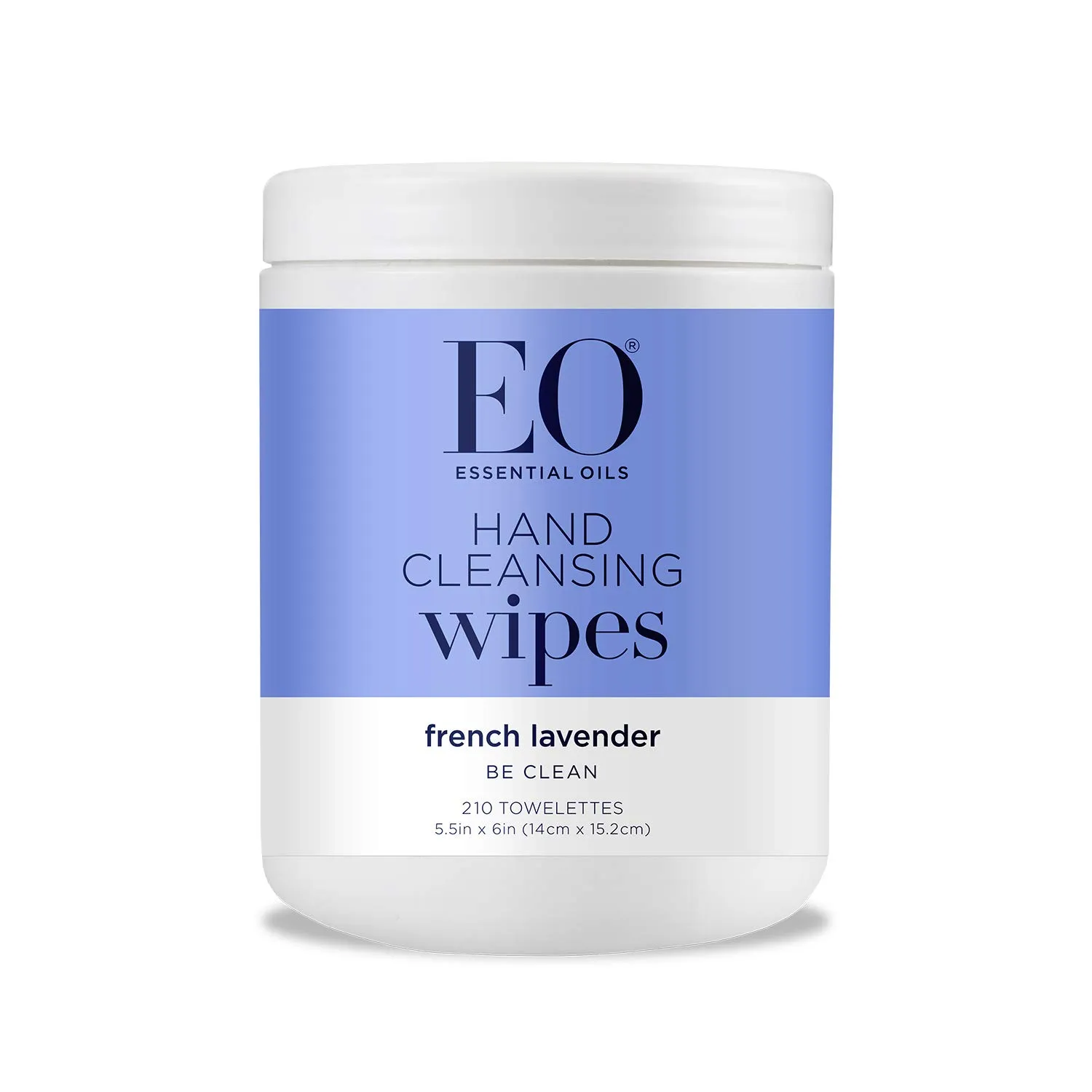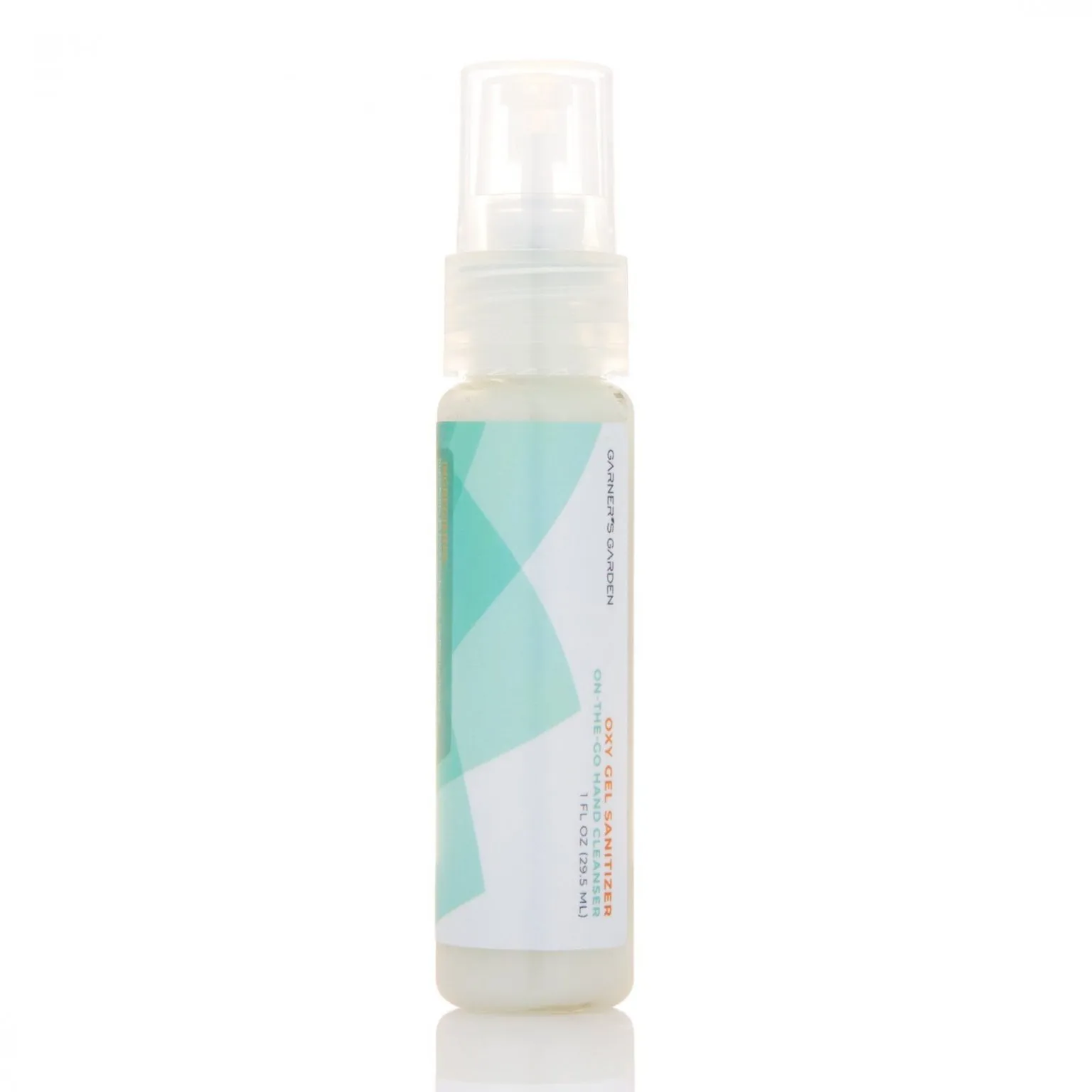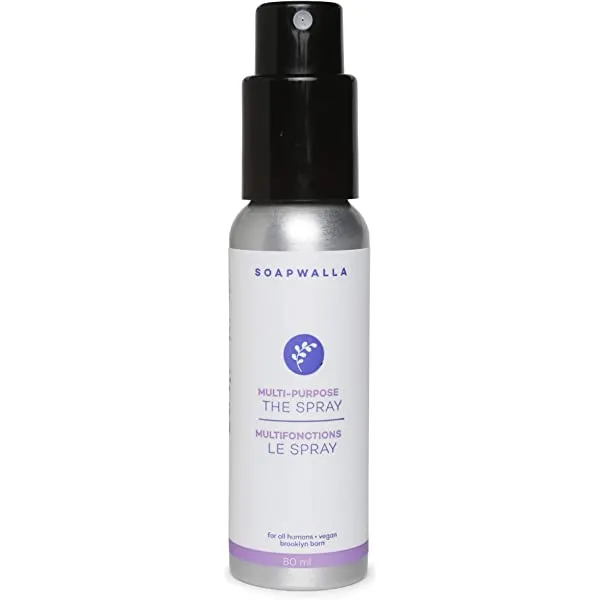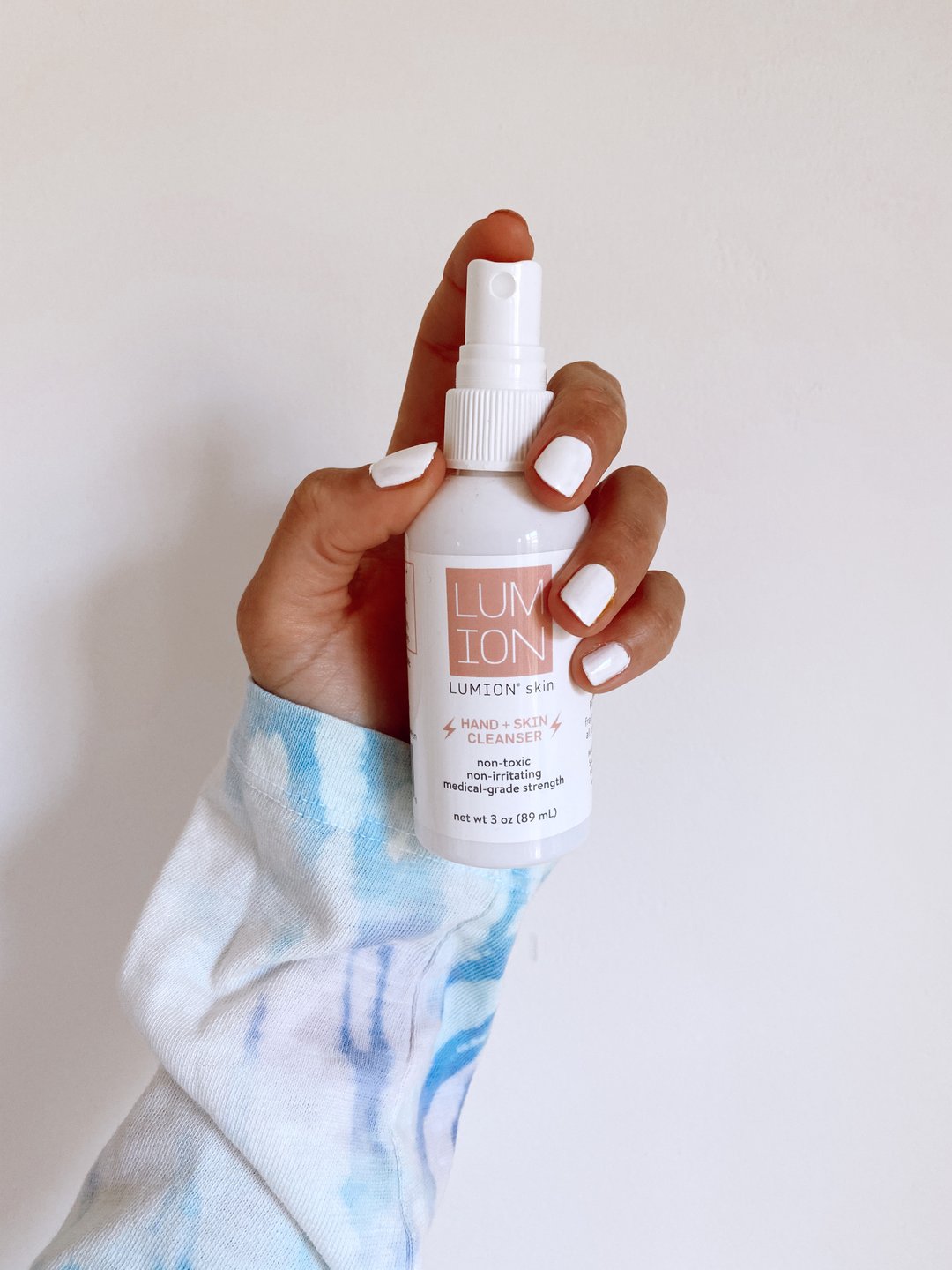Non-Toxic Hand Sanitizer Guide
Written by:
Maia James
11/04/2020

Updated: 04/04/2024
Looking for a different guide? Browse them all HERE.

1. All Good / 2. for:good / 3. Soapwalla/ 4. Lumion/ 5. Aura Cacia
Research provided by Michael Hopkins, PhD
So you’re looking for non-toxic hand sanitizer…You’ve come to the right place! But buckle up, my friend, because there is a lot of info in this guide! (That’s what I get every time I hire Dr. Hopkins to provide research!).
Below, you’ll find everything you need to know when shopping for non-toxic hand sanitizers–from sprays, gels, foams and wipes.
(Since probably most of you are reading this through a lens of COVID-19 worries, here is the good news: the novel coronavirus is very easy to kill with truly non-toxic hand sanitizers.)
Non-Toxic Hand Sanitizer: Sprays Vs. Gels Vs. Wipes
Generally speaking, you’re more likely to find a non-toxic hand sanitizer in a spray form than either a gel or a wipe.
This is because gels usually have some kind of thickening agent that sprays don’t need, giving one more opportunity for Bad Stuff to get into the formula.
Wipes are least likely to be Good Stuff because they are by nature disposable and involve more packaging as well as the cloth itself, which may or may not be Good Stuff. and then for some reason almost all wipes have preservatives in the ingredient list, which is weird since they are soaked in disinfectant solution already.
Soap Versus Hand Sanitizers
As you surely know by now, the CDC recommends that any alcohol-based hand sanitizers contain 60% or more alcohol in order to be effective against the novel coronavirus.
The CDC also is clear that washing your hands with soap and water (for 20 seconds or more) will effectively rid your skin of the coronavirus. When using soap, you don’t need any disinfectant at all to kill the virus that causes COVID-19. Any old soap will work because of the virus’ lipid membrane, aka “envelope.” Enveloped viruses, like SARS-CoV-2, are among the easiest pathogens to kill.
Bottom line: if you’re only concerned with COVID-19, it’s okay to use soap that is not labeled as “antimicrobial” or “antibacterial.”
This guide is a review of a broad range of antimicrobial hand sanitizing gels, sprays, and wipes that will kill more than just coronavirus–because this pandemic will end some day! Hand soap will be covered in a future guide.

Cleaning Versus Disinfecting
To truly disinfect a surface, you need to scrub an area until the entire surface is wet, and then let it dry with time.
The mechanical process of scrubbing physically wipes away the germs, and the disinfecting agent offers extra assurance that any remaining virus/bacteria will be killed.
It’s also crucial to use enough of the product—and to allow it to sit long enough—to make sure it really works.
Here’s how Clorox says to disinfect hard, nonporous surfaces with its wipes: “Use enough wipes for treated surface to remain visibly wet for 4 minutes. Let surface dry.”
What Are the Hardest Bugs to Kill?
Let me repeat the good news: the novel coronavirus is among the easiest pathogens to kill. This is because of it’s lipid membrane, or “envelope.” Enveloped viruses, which include influenza, are easy to kill. (By the way, a product is allowed to market itself as able to kill the coronavirus if it is proven to kill at least one virus that is harder to kill than this coronavirus.)
But what if you’re worried about other microbes?
Certain viruses, like the norovirus (which causes the stomach bug) and rhinovirus (which causes the common cold), are among the hardest bugs to kill, and both are resistant to ethanol-based antiseptics as well as quaternary ammonia (you’ll learn more about these ingredients later).
Rotavirus and adenovirus are also non-enveloped viruses, but they are bigger making them more vulnerable than their smaller non-enveloped cousins. Many bacterial endospores can be killed by alcohol-based hand sanitizers.
And what about mold and yeast? Most people worried about a fungal infection will use a product that is specifically fungicidal. That said, the most common household fungal pathogens (like ringworm and athlete’s foot) are generally susceptible to common household antimicrobial products, such as alcohol or bleach.
(By the way, a product is allowed to market itself as able to kill the coronavirus if it is proven to kill at least one virus that is harder to kill than this coronavirus.)

Antiseptic Versus Disinfectant
“Antiseptic” refers to products used on living tissue (like your hands), and “disinfectant” is reserved for products that will be used on inert surfaces (like an airplane tray table).
The Essential Components in Hand Sanitizer
Any hand sanitizer, be in conventional or “natural” will likely contain a combination of the following components:
- Antiseptic (“active ingredient”). The truth is, an antimicrobial hand product really only needs one ingredient–an effective antiseptic. You will read more about which active ingredients kill which microbes in the next section. The acceptable active ingredients for a product to meet our Good or Best Stuff designation are alcohol (either ethanol or isopropanol, 60-80%), thymol and/or citral, and hypochlorous acid. Note that alcohol enhances the absorption of other topical ingredients into the skin. It’s therefore especially important that alcohol-based sanitizers have an otherwise safe list of ingredients.
- Moisturizer/skin conditioner. Given that alcohol is the most common active ingredient in non-toxic hand sanitizer, it’s important to consider what will counteract its drying effects, especially in these times where we are using it many times every day. The three most common moisturizing ingredients in the Good Stuff brands are aloe, coconut oil (or some other non-petroleum oil such as macadamia, or even olive oil), hyaluronic acid (this can be a tricky ingredient as this may be sourced from plants, synthetic, or rooster comb), and glycerin. Sucrose cocoate is another natural emollient that appears to be safe.
- Aromatics. The third item that you will find in most hand sanitizers is some kind of pleasant aroma. The most common source of safe and clean fragrances are essential oil (EO) extracts, which are both natural and generally non-toxic. One caveat is that many terpenes (the aromatic molecules found in so many essential oils–for example, geraniol, linalool, limonene, citral, and eucalyptol) are known to be potential skin irritants. If you’ve had a reaction to topical essential oils in the past, you may want to avoid hand sanitizers with essential oils or any isolated terpenes from essential oils.
- Thickening/gelling agent. For non-toxic hand sanitizers that come in a gel form, there is often an ingredient added to thicken the liquid into a gel. Good Stuff approved thickeners include aloe, hydroxyethylcellulose, xantham gum and guar. There are other thickening ingredients that we feel are Okay Stuff, all of which EWG rates as a 1, but because they are synthetic polymers we can’t quite call them Good Stuff.
Antibiotic-Resistant Bacteria: Should We Be Worried?
Yes, you can be concerned about this generally, but not when it comes to hand sanitizers and surface disinfectants, says Dr. Hopkins.
Because of the way these products kill pathogens (physically breaking apart the microorganism or disrupting fundamental cell processes), they are not susceptible to resistance in the same way as antibiotic drugs are.
There are examples of microorganisms being forced into resistance in the laboratory, but no examples in the real world, according to this article from Infection Control Today.
Common Antimicrobial Ingredients
Here are the germ-killing ingredients you’ll find in hand sanitizers as well as disinfection cleaning products.

#1 Hypochlorous Acid
HOCl, also referred to as “superoxidized water” is produced by electrolysis of salt water (H2O + NaCL).
Dr. Hopkins describes hypochlorous acid as: “awesome, because it kills basically every type of pathogen very quickly and it also happens to be a substance that is naturally produced by our own cells and is even safe to ingest.”
HOCI does have a little bit of a chloriney smell, which may be a turnoff for some. The only hand sanitizer that we know of that uses HOCI is this one from Lumion.
#2 Alcohol
Alcohol is an effective broad spectrum antimicrobial, meaning it will kill most viruses, funguses, and bacteria.
Sanitizers that are 60% to 90% alcohol will kill germs most effectively, provided that at least 2.4 milliliters of hand sanitizer is applied for 25 to 30 seconds.
It’s important to note that 70% alcohol is better than 99% because it does not evaporate as quickly, meaning it continues working longer.
You’ll see ethanol or isopropyl on the label, and many non-toxic hand sanitizers (Best Stuff and Good Stuff, below) rely on alcohol as their active ingredient.
#3 Accelerated Hydrogen Peroxide
This is effective against a broad spectrum of microbes, including H1N1 (Influenza A), norovirus, and MRSA.
Hydrogen peroxide at 3% concentration can be used to disinfect most surfaces, but can cause discoloration and must never be mixed with vinegar or bleach. Note that hydrogen peroxide will lose potency if exposed to light.


#4 Sodium Hypochlorite (Chlorine/Bleach) 5.25%
Bleach is effective against most bacteria and some viruses and is registered as effective against HIV, HBV, H1N1 (Influenza A), MRSA, and TB.5. Chlorine is a serious threat to the health of humans and wildlife (it’s linked cancer and endocrine disruption). You won’t find bleach in hand sanitizers, but you will find it in disinfectant cleaning products for the home.

#4 Quaternary Ammonium Compounds (Benzalkonium Chloride)
This ingredient is generally effective against a broad spectrum of microbes, including MRSA and H1N1 (Influenza A). It has not been proven effective against spores. This ingredient is found in many “natural” hand sanitizers, making it Sneaky Stuff.
#5 Botanicals (Thymol, Citral)
Both thymol and citral are effective against a broad spectrum of microbes including H1N1, tuberculosis, MRSA, and coronaviruses. The CDC includes thymol and citral in its list of approved active ingredients for destroying the coronavirus.
#6 Vinegar
Vinegar is a great household cleaner, and it will kill some germs–but it’s not as effective as most other household antimicrobials and not recommended as a natural hand sanitizer.
#6 Essential Oils (EOs) and their Constituent Compounds
I’ll quote Dr. Hopkins here: “Most articles I found seem to take a needlessly conservative position on essential oils as being effective antimicrobials.” Dr. Hopkins said he found a large and growing body of literature describing the antibacterial, antifungal, and antiviral properties of many different components of many different essential oils. Some things to keep in mind:
- Inhibiting the growth or proliferation of a pathogen and destroying the pathogen are two different things. For the purposes of a hand sanitizer or surface disinfectant, we want to know that the active ingredient destroys the pathogen, not simply inhibits its growth.
- There is a tremendous amount of variability with regard to which EO compounds can destroy which pathogens and overall, much more research has been conducted to understand the antibacterial properties of EOs versus their antiviral activity.
- Some key EOs containing compounds known to have powerful bactericidal activity are: Thyme, Verbena (Borneol, Geraniol).
- Some key EOs containing compounds known to have powerful fungicidal activity are: Cinnamon, Pine.
- Some key EOs containing compounds known to have powerful virucidal activity are: Cinnamon, Bergamot, Lemongrass, Thyme, Yarrow, Wormwood and Kumquat.laim.
So if you are looking to buy a hand sanitizer or surface disinfectant that does not contain alcohol, hypochlorous acid, hydrogen peroxide, sodium hypochlorite, or quaternary ammonium chlorides, you can consider the EO components listed above depending on what you’re specifically worried about killing.
More on essential oils and their antiseptic properties can be found here.
Non-Toxic Hand Sanitizers: Classic Four Ingredients
There is one combination of four key ingredients in many natural, non-toxic hand sanitizers. The list includes: alcohol, glycerin, hydrogen peroxide, and water. Aura Cacia makes one example of a “Classic Four” non-toxic hand sanitizer that we sell in our store. You can also find this combo of ingredients in many brands–and it’s Good Stuff approved.
Other Ingredients: Okay Stuff
Dr. Hopkins compiled the following list of common hand sanitizer ingredients whose “main crime is being unnecessary rather than outright toxic.” In most cases, if a product has one or two of these ingredients it may still receive a Good Stuff rating, but any more than that generally will drop the product to being rated as only Okay Stuff.
- Allantoin: This is an emollient/skin conditioner/skin protectant. Although it can be isolated from plants, it is most often synthetic. EWG score: 1.
- Ammonium polyacryloyldimethyl taurate: This is a synthetic polymer that’s used as a thickening agent in some hand sanitizers brands. Because Dr. Hopkins was unable to find any safety data on this ingredient, any brand with this ingredient will not be designated as Good Stuff. EWG score: 1.
- Carbomer (polyacrylic acid): This refers to synthetic high molecular weight polymers of acrylic acid commonly used as thickening, dispersing, emulsifying, humectant/gel-forming compound. Not Good Stuff because it’s synthetic polymer, but benign from a safety standpoint. EWG score 1.
- Decyl Glucoside: This is a natural surfactant derived from glucose and is considered safe and non-toxic. Can be found in Good Stuff non-toxic hand sanitizers. EWG score:1.
- Dimethicone: This silicone lubricant is problematic in cosmetics generally because it can form a barrier on the skin and clog pores. However, when it’s used in a hand sanitizer, that can be a good thing for moisture retention. Dimethicone alone will not knock a hand sanitizer out of the Good Stuff category. EWG score: 1.
- Disodium EDTA: This preservative isn’t in itself Bad Stuff, but it is a penetration enhancer, which means any not-so-great ingredients in the product will be more readily absorbed. Sanitizers with EDTA in their formula will only be rated Okay Stuff or lower. EWG score: 1.
- Glycerith-26: This is an additive in many foods as well as cosmetics, and it was difficult to find any studies on it. Dr. Hopkins finally found a good toxicity report and is confident that this a safe/non-toxic ingredient. EWG score: 1.
- Hydroxypropyl cellulose: This is a propylene glycol ether of cellulose used as a gelling and viscosity increasing agent. This derivative is considered safe. EWG score: 1.
- Hydroxyproyl guar: This is a propylene glycol ether of guar used as a gelling and viscosity increasing agent. This derivative is considered safe however I don’t love that it’s manufactured using propylene glycol. EWG score: 1.
- Panthenol: This is a natural biologically active alcohol derived from plants, and is regarded as safe. EWG score: 1.
- Piroctone olamine: This synthetic preservative/biocide is most commonly used in dandruff shampoo and there is no reason it needs to be added to hand sanitizers. Dr. Hopkins decided to allow it into our Okay Stuff category. EWG score: 1-2.
Problem Ingredients You’ll Find Even in “Natural” Hand Sanitizers
The most problematic ingredients in hand sanitizers are typically preservatives, colorants, fragrances and conditioning, buffering, or texturizing agents.
The following ingredients, if present in significant amounts, knocked hand sanitizers into Sneaky or Bad Stuff categories in our review. Some of them are okay if less than 1% of the product.
- Aminomethyl propanol: This buffering agent is a possible skin irritant and can be contaminated with toxic nitrosamines.. EWG score: 1-3.
- Benzalkonium chloride (BAK): This is a widely used quaternary ammonium antiseptic and is the active ingredient in many “natural” hand sanitizers. BAK is a known skin irritant at concentrations of 0.5% and above and induce and exacerbate allergic dermatitis. It is also known to cause respiratory irritation and should be avoided by people with asthma.
- Copper sulfate pentahydrate: This biocide is a mixture of copper and sulfur. It’s not ranked by EWG, and Dr. Hopkins feels it’s basically safe for humans, but it is a pesticide that poses concerns as an environmental toxin.
- Dyes/colorants: Even if they are “food grade,” at best these would make a hand sanitizer Sneaky Stuff because they are totally unnecessary!
- Grapefruit seed extract (may be found on a label as “citricidal”): This is a synthetic compound which, in its final form, has a large percentage of diphenol hydroxybenzene. The chemical structure contains benzene rings, which are problematic due to their ability to mimic estrogen and bind to estrogen receptors. Do not confuse this with grapefruit essential oil.
- Fragrance (or “parfum”): This is a very common problem ingredient that may contain phthalates.
- Preservatives (found most often in hand sanitizing wipes): These include parabens (hormone disruptors), potassium sorbate, sodium benzoate, methylisothiazolinone (EWG: 7), and methylchloroisothiazolinone (EWG: 2-5). There is simply no need for any of these in your hand sanitizer, and plenty of options without them.
- Propylene glycol: This synthetic liquid absorbs water and is used as a solvent, skin conditioning agent, and viscosity controlling agent. PG is a penetration enhancer and can cause skin irritation.
- Tocopherol/tocopheryl acetate: Vitamin E and synthetic Vitamin E, respectively. This is used to prevent the drying effects of alcohol-based skin products. Unfortunately, tocopherol and tocopheryl acetate can be contaminated with hydroquinone, which is a possible carcinogen (EWG score: 5-8). The rub is that although tocopherol is the natural form of Vitamin E, it can also be produced synthetically and potentially be contaminated with hydroquinone. You can’t tell from the label. If a hand sanitizer says “Vitamin E” or tocopherol and it is otherwise Good Stuff, we contacted that brand to find out how it was sourced.
- Triclosan: This has been banned from topical skin products, so we didn’t come across any brands that contained it. Triclosan is decidedly toxic, so if you see any kind of disinfecting products that contain it, they should be avoided.
- Triethanolamine: A a strong respiratory allergen and suspected immune system toxicant. EWG score 2-5.
38 Hand Sanitizer Brands, Reviewed
What you’ve just read is maybe 30% of the information that Dr. Hopkins provided in his final report. I hope you’re still with us;), because now is that time where we will just tell you what to buy and where to buy it–or why the brand you’re currently using is toxic–because we are fun like that!
Best Stuff
All Good Natural Hand Sanitizing Gel or Spray
BEST GEL
This is my favorite natural hand sanitizer. Its active ingredient is ethyl alcohol (62%). It also contains a handful of other natural ingredients, like aloe, calendula, chamomile, and glycerin.

Aura Cacia Natural Hand Sanitizer
This is a very simple, clean option. This liquid formula contains just Alcohol (80%), glycerin, hydrogen peroxide, and purified water.

By HumanKind Hand Sanitizer
This one has a very simple ingredient list of just alcohol, water, and hyaluronic acid. We confirmed by contacting the company that the hyaluronic acid is vegan. It’s sold in arecycled aluminum bottle for refilling your existing disposable plastic bottles.

Cabinet Instant Hand Cleanser
Made from only two ingredients–alcohol and a blend of essential oils–it really doesn’t get more straightforward than this. My only concern would be that there is no moisturizing/skin conditioning ingredient so dryness will be a concern with frequent use.

Clean Smart Antimicrobial Hand Cleanser
This is good option for anyone who wants an alcohol-free non-toxic hand sanitizer without any essential oils. This formula contains water, salt, and NaCl hypochlorite ion.

Dr Bronner’s Organic Hand Sanitizer Spray
Alcohol, lavender, and with glycerin to hydrate your hands.

EO Hand Cleansing Wipes (Lavender)
With just four organic ingredients, soaked into a cloth made of environmentally sustainable bamboo, these are a great choice if you want a wipe.

everyone Hand Sanitizer Wipes, Coconut + Lemon
Just keep in mind these are individually wrapped, so this brand involves more packaging.

For:Good Hand Sanitizer Wipes
BEST WIPE
We love this one for it’s short list of organic ingredients. This is our top recommendation for a natural hand sanitizer in wipe form.

Garner’s Garden Natural Hand Sanitizer
This brand has a simple ingredients list of 70% alcohol with essential oils and moisturizing safflower oil. Black-owned business.

Hairizon Hand Sanitizer
This formula is just glycerin, hydrogen peroxide, and essential oils of your choice.

Highline Wellness CBD Hand Sanitizer
This is made of only alcohol (70%), glycerin, and CBD.

Lumion Medical Strength Hand Sanitizer
BEST SPRAY
This super clean formula is just hypochlorous acid.

Oliveberry Organic Hand Sanitizer Spray
This formula contains only grain alcohol, organic aloe, glycerin and essential oils. It comes in recyclable glass bottle.

Paume Moisturizing Antibacterial Gel
69% ethyl alcohol kills 99.9% of harmful germs and bacteria while premium plant based emollients deliver long lasting hydration and nourishment to your skin.

Poofy Organics Clean Clappers Hand Purifier
Contains a blend of essential oils, with aloe and glycerin. Alcohol-free.
Use code: MAIAJAMES for 10% off

Primally Pure Hand Sanitizer Spray
This one gets bonus points because it comes in recyclable glass bottle.
Use code: GIMMETHEGOODSTUF10
Skin Smart Antimicrobial Wound Therapy
This formula contains just water, salt, and NaCl hypochlorite ion.

Soapwalla the Spray
BEST FOR CLEANING YOGA MATS
With only two ingredients (rose water and a blend of essential oils), it doesn’t get any simpler than this. Litsea Cubeba, Rosemary, Tea Tree, Lavender, Eucalyptus, Niaouli and Palmarosa oils discourage bacteria, viruses, and fungi. Note that this formula is not explicity approved to kill the coronavirus.

Tazza Hand Sanitizing Wipes
They make a great ethanol wipe, but their version that contains benzalkonium chloride should be avoided.

Touch Body Works Hand Sanitizer with Aloe Gel
This formula contains just five clean ingredients. We confirmed that the vitamin E is natural.

Wipeys Hand Sanitizer Wipes
This formula contains just five clean ingredients. We confirmed that the vitamin E is natural.

Good Stuff
EO Hand Sanitizing Gels
Again, alcohol is the antimicrobial here, and the other ingredients include glycerin, jojoba seed oil, and dimethicone.

Green Goo Hand Sanitizer
This is a simply formula with alcohol, carbomer, and water.

Young Living Theives Waterless Hand Sanitizer
This blend of alcohol, aloe, glycerin, and various essential oils would be Best Stuff except for the hydroxypropylcellulose.

Bad Stuff
Germ X is the other big name hand sanitizer brand that should be avoided, mostly because of fragrance and artificial coloring.
Sneaky Stuff
Contains propylene glycol.
Aesop Resurrection Rinse-Free Hand Wash
This one weirdly doesn’t contain enough alcohol to even for sure be effective against COVID (58-62%, per the bottle). It also contains several PEG chemicals and is super expensive. The only upside? It comes in a glass bottle.
Babyganics Alcohol-Free Hand Wipes
These contain benzalkonium chloride,
This one also contains undisclosed fragrance and we haven’t heard back from them with more details. It also contains allantoin.
In general this brand makes Okay and Good Stuff, but the Coastal Surf “flavor” says it contains Citronellal, which is a synthetic derivative of a natural EO . The label says “no synthetic fragrance” so that right there makes it Sneaky. In addition, we never heard back from them about “proprietary ingredients.”
Contains propylene glycol.
Mrs. Meyer’s Clean Day Hand Sanitizer
This brand that you’ll see on most of our Sneaky Stuff lists, and unfortunately, hand sanitizer is no exception—thanks to their signature synthetic fragrance.
Contains fragrance oil, which it specifies is phthalate-free. We generally do not endorse products that don’t disclose exactly which ingredients are in fragrance blends. We called the company to get more details on the fragrance oil as well as their vitamin E, but we didn’t hear back.
Contains propylene glycol.


Maia, Founder & CEO
Note: This article contains affiliate links or sponsored content, which means that if you make a purchase, we may earn a commission. We only recommend products that meet our strict standards for non-toxicity and that we use (or want to use!) ourselves. Thank you so much for supporting the brands that make Good Stuff!
Enjoying this guide?
Join 60K families who rely on our free guides on everything from milk to mattresses! Sign up to get $5 off your first order, access to our ultimate Clean Products Cheat Sheet, and ongoing exclusive access to coupon codes and promotions. Our weekly newsletter is filled with well researched tips and tricks to live a toxin-free lifestyle.
Related Posts
The Best Natural Soap Guide 2024
Non-Toxic Air Freshener Guide
The Best Non Toxic Toothpaste Guide
How to Choose the Best Air Filter
-
Thank you! What is your take on Pipette?
-
I don’t know this brand but will take a look!
-
I look forward to hearing what you think of Pipette! I was hoping to find it on the updated guide!
-
-
-
Have you looked at the Honest brand Alcohol Wipes? Wondering how they compare?
-
How do you feel about Hello Bello brand? Thanks
-
In general they are pretty good!
-
-
Great post, much needed in today’s world. I really appreciate seeing an expanded list of safe hand sanitizers.
-
Thanks so much for all your work on getting this information out, Maia! It’s so important! Your guide on Hand Sanitizer is so helpful. If you’re open to another addition, I suggest Pure Haven hand sanitizer: https://shop.bydesign.com/PureHaven/#/shop/detail/95115s/from/26967 The ingredients are amazing and it leaves your hands feeling fresh instead of sticky. I’m an elementary school teacher, and now being back in the classroom four days a week in a hybrid model, it has been an amazing product to use throughout the day.












Leave a Reply
You must be logged in to post a comment.